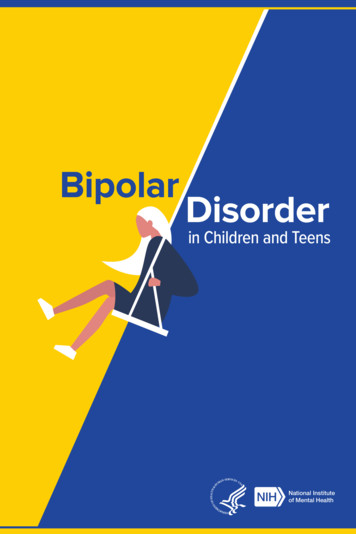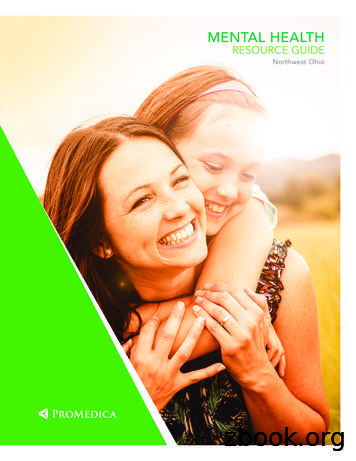Conduct Disorder What Is Conduct Disorder - California State University .
10/20/2009 Conduct Disorder What is Conduct Disorder “Conduct disorder is a common childhood psychiatric problem that has an increased incidence in adolescence. The primary diagnostic features of conduct disorder include aggression, theft, vandalism, violations of rules and/or lying.” (Searight, H.R., Caitlin Robles, Amanda DeCarl, Trisha Koch, Alex Weathers, & Summer Henney Features Rottnek, F., & Abby, S.L. ,2001) Etiology Unable to understand others’ welfare Little guilt Lie about remorse to avoid punishment View others as threatening or malicious May lash out and be aggressive without provocation. Conduct disorder is caused by an interaction of genetic, familial, and social factors. A child with a neurological condition or genetic predisposition and familial or social deprivation can develop conduct disorder. (Searight, H.R., Rottnek, F., & Abby, S.L. ,2001) Etiology: Genetic/Physical Factors Autonomic under-arousal. Brain damage to the pre-frontal cortex (Searight, H.R., Rottnek, F., & Abby, S.L. ,2001) (American Academy of Child & Adolescent Psychiatry, 2004) Insensitivity to physical pain and punishment Learning impairments Neurological factors due to birth complications or low birth weight (Surgeon General) Etiology: Familial Factors Exposure to parental antisocial behavior is the most influential factor. Parental substance abuse, psychiatric illness, marital conflict, child abuse, and neglect Poverty Parent absence Inconsistent discipline and consequences (Searight, H.R., Rottnek, F., & Abby, S.L. ,2001) 1
10/20/2009 Major Components in Diagnostic Assessments for Conduct Disorder Etiology: Social Factors School failure Traumatic life events E l institutionalization Early i tit ti li ti More susceptible to peer influence Parent/Child/School Interviews and Questionnaires Direct Observation Measurement of DSM-IV criteria Determining subtype of the disorder Determining possible concurring disorders (American Academy of Child & Adolescent Psychiatry, 2004) (Surgeon General) (Searight, H.R., Rottnek, F., & Abby, S.L. ,2001) (Hughes, T.L, Crothers, L.M., & Jimerson, S.R., 2008) DSM-IV Diagnostic Criteria for Conduct Disorder Examples of Tools used in Parent and/or Child Interviews/Questionnaires A. A repetitive and persistent pattern of behavior in which the basic rights Broad-Band Behavioral Rating Scales Dyadic Parent-Child Interaction Coding System Minnesota Multiphasic Personality Inventory Dominic-R B. B C. D. E. F. G. (Hughes, T.L, Crothers, L.M., & Jimerson, S.R., 2008) H. I. DSM-IV Diagnostic Criteria for Conduct Disorder Cont. J. K. Is often truant from school, beginning before age 13 years. The disturbance in behavior causes clinically significant impairment in social, academic or occupational functioning. L. If the individual is age 18 years or older, criteria are not met for antisocial personality disorder. Specify severity: Mild: few if any conduct problems in excess of those required to make the diagnosis, and conduct problems cause only minor harm to others. Moderate: number of conduct problems and effect on others intermediate between "mild" and "severe." Severe: many conduct problems in excess of those required to make the diagnosis, or conduct problems cause considerable harm to others. of others or major age-appropriate societal norms or rules are violated, as manifested by the presence of three (or more) of the following criteria in the past 12 months, with at least one criterion present in the past six months: Aggression to people and/or animals Often bullies, bullies threatens or intimidates others. others Often initiates physical fights. Has used a weapon that can cause serious physical harm to others (e.g., a bat, brick, broken bottle, knife, gun). Has been physically cruel to people. Has been physically cruel to animals. Has stolen while confronting a victim (e.g., mugging, purse snatching, extortion, armed robbery). Has forced someone into sexual activity. Destruction of property Subtypes Childhood Onset: Prior to Age 10 Worse prognosis if left untreated. Aggression, property destruction, & poor relationships are common features. 40% of childhood onset conduct disorder transitions into antisocial personality disorder Adolescent Onset: After Age 10 Social context should be taken into consideration. Gang culture & survival needs (e.g., stealing food) do not suggest as serious a psychological disturbance as conduct disorder. (Searight, H.R., Rottnek, F., & Abby, S.L. ,2001) (APA, 1994) 2
10/20/2009 Red Flags Among children age 10-14 years old there are several red flags for conduct disorder: Smoking Sexual activity Alcohol and drug use (Searight, H.R., Rottnek, F., & Abby, S.L. ,2001) Comorbidity Conduct disorder can be comorbid with other disorders: Oppositional Defiant Disorder ADHD 80% Depression 50% Anxiety 40% Mood Disorders (i.e. bipolar & depression) Substance Abuse (Ollendick, T.H., Jarret, M.A., Grills-Taqueche, A.E., Hovey, L.D., & Wolf, J.C., 2008) (Hughes, T.L, Crothers, L.M., & Jimerson, S.R., 2008) Examples of Different Types of Treatment School-Based Intervention Strategies Specialized Programming: Classroom Level Specialized Programming: Comprehensive Strategies (Hughes, T.L, Crothers, L.M., & Jimerson, S.R., 2008) Examples of Different Types of Treatment Interventions to Promote Prosocial Skills Parent Management Training Contingency Management Programs Cognitive Problem-Solving Skills Training Functional Family Therapy Group Therapy Psychopharmacologic Interventions (Hughes, T.L, Crothers, L.M., & Jimerson, S.R., 2008) Examples of Different Types of Treatment Multidimensional Interventions Multisystemic Therapy Families l and d Schools S h l Together h (FAST ( S TRACK) C ) *The diagnosis of CD does not qualify a child for Special Education UNLESS it’s comorbid with one of the 13 disabilities that is under Special Education (Hughes, T.L, Crothers, L.M., & Jimerson, S.R., 2008) WHAT SCHOOLS CAN DO * With a 504 plan or a behavioral plan, accommodations can be made for students with CD Specialized Programming: Classroom Level Create a structured, predictable environment Instruction should be consistent and methodical Sufficiently staffed environment Material should be presented in: Consistent manner Systematic instructional routines Cumulative manner (Hughes, T.L, Crothers, L.M., & Jimerson, S.R., 2008) 3
10/20/2009 SPECIALIZED PROGRAMMING: COMPREHENSIVE STRATEGIES SPECIALIZED PROGRAMMING: COMPREHENSIVE STRATEGIES CONT. Student-Focused Approaches School-Focused Approaches Teachers and mental health professionals address mental and social processes that affect behavior Through instruction, teachers need to create a balance in the classroom between the needs of specific children and the rest of the classroom Examples of interventions: modeling modeling, role role-play play, immediate positive reinforcement of target behaviors Examples of interventions: smooth transitions, being consistent and direct with praise and redirection, clear classroom rules stated first day of class and emphasized throughout the year, social skills curriculum, teamwork curriculum Parent-Focused Approaches Parents can recognize influences at home that are affecting the child’s behaviors Examples of interventions: coaching, prompting, feedback, graduated homework assignments (Hughes, T.L, Crothers, L.M., & Jimerson, S.R., 2008) (Hughes, T.L, Crothers, L.M., & Jimerson, S.R., 2008) Parent Management Training Functional Family Therapy Focus on making changes within the family system Improve communication skills and family interactions Parents are trained to use specific procedures in the home: 1. Improve parent-child interactions Cognitive Problem-Solving Skills Training Focus on improving child’s social skills using bl l i techniques t h i problem-solving warmth and responsiveness 2. Promote pro-social behaviors Self-statements Multiple solutions Understanding others’ perspectives reinforcement of desirable behaviors 3. Discourage negative behaviors Group Therapy structured home environment clear rules and expectations consistent discipline Focus on development of interpersonal skills Interaction with positive peer role models (Hughes, T.L, Crothers, L.M., & Jimerson, S.R., 2008) Pharmacotherapy Commonly used when comorbidity exists (ADHD, mood disorders) Used in combination with other treatments Treats specific symptoms: Stimulants (aggression) Anti-convulsants (rage and temper outbursts) Lithium (aggression) Clonidine (over-arousal) Neuroleptics and Atypical Antipsychotics (severe CD) (Hughes, T.L, Crothers, L.M., & Jimerson, S.R., 2008) Surprise! Pop Quiz with Candy to Bribe/Entice you to Answer!!!! Don't worry, these will be taken straight from the powerpoint!!! 1. 2. 3. 4. 5. Conduct Disorder is a common problem? psychiatric Students with Conduct Disorder may lie about remorse to avoid ? punishment Conduct Disorder is caused by . Caused by an interaction of genetic, familial, and social factors. Name 4 Social factors of Conduct Disorder? School Failure, Traumatic Life events, early institutionalization, & more susceptible to peer influence. Does Conduct Disorder meet the requirements for special education? The diagnosis of CD does not qualify a child for Special Education UNLESS it’s comorbid with one of the 13 disabilities that is under Special Education, but they do qualify for a 504 plan / behavioral plan, and accommodations in the school can be made. 4
10/20/2009 References American Academy of Child & Adolescent Psychiatry. (2004). Conduct disorder. Retrieved from http://www.aacap.org/cs/root/facts for families/conduct disorder American Psychiatric Association. (1994). Diagnostic and statistical manual of mental disorders. 4th ed. Washington, D.C.: American Psychiatric Association. Hughes, T.L, Crothers, L.M., & Jimerson, S.R. (2008). Identifying, assessing, and treating conduct disorder at school. New York: Springer. Ollendick, T.H., Ollendick T H Jarret, Jarret M.A., M A Grills-Taqueche, Grills Taqueche A.E., A E Hovey, Hovey L.D., L D & Wolf, Wolf J.C. J C (2008). (2008) Comorbidity as a predictor and moderator of treatment outcome in youth with anxiety, affective, attention deficit/hyperactivity disorder, and oppositional/conduct disorders. Clinical Psychological Review, 28(8), 1447-1471. Searight, H.R., Rottnek, F., & Abby, S.L. (2001). Conduct disorder: Diagnosis and treatment in primary case. American Family Physician, 63(8), 1579-1588. Surgeon General. Other mental health disorders in children and adolescents. Mental Health a Report of the Surgeon General (3). Retrieved from /chapter3/sec6.html 5
40% of childhood onset conduct disorder transitions into antisocial personality disordertransitions into antisocial personality disorder Adolescent Onset: After Age 10 Social context should be taken into consideration. Gang culture & survival needs (e.g., stealing food) do not suggest as serious a psychological disturbance as conduct disorder.
F41.1 Generalized anxiety disorder F40.1 Social phobia F41.2 Mixed anxiety and depressive disorder F33 Recurrent depressive disorder F43.1 Post-traumatic stress disorder F60.31 Borderline personality disorder F43.2 Adjustment disorder F41.0 Panic disorder F90 Hyperkinetic (attention deficit) disorder F42 Obsessive-compulsive disorder
9417 Depersonalization disorder SOMATOFORM DISORDERS 9421 Somatization disorder 9422 Pain disorder 9423 Undifferentiated somatoform disorder 9424 Conversion disorder 9425 Hypochondriasis MOOD DISORDERS 9431 Cyclothymic disorder 9432 Bipolar disorder 9433 Dysthymic disorder 9434 Major depres
Some children and teens with these symptoms may have . bipolar disorder, a brain disorder that causes unusual shifts in mood, energy, activity levels, and day-to-day functioning. With treatment, children and teens with bipolar disorder can get better over time. What is bipolar disorder? Bipolar disorder is a mental disorder that causes people to experience . noticeable, sometimes extreme .
Subthreshold Bipolar. Disorder. Bipolar II Disorder. Bipolar I Disorder. Psychiatrist. General Medical. No Treatment. Adapted from: Merikangas, et al.1 in Arch Gen Psychiatry. 2007;64(5):543552- The proportion of individuals with bipolar I disorder, bipolar II disorder or subthreshold bipolar disorder
ADD/ADHD Anger/Aggression Anxiety Disorder Autism Spectrum Disorder Bipolar Disorder Borderline Personality Bullying Conduct Disorder Cutting/Self Harm Depression Dual/Concurrent/Co-Morbid Eating Disorders Fetal Alcohol Spectrum Disorder Grief Learning Disability Mood Disorders Obsessive Compulsive Disorders Oppositional Defiant Disorder
Generalised anxiety disorder (GAD) Obsessive compulsive disorder (OCD) Health Anxiety Panic disorder Post traumatic stress disorder (PTSD) Social anxiety disorder Specific phobias Separation anxiety disorder
INTERPRETING A PEDIGREE CHART 2. Determine whether the disorder is dominant or recessive. If the disorder is dominant, one of the parents must have the disorder. If the disorder is recessive, neither parent has to have the disorder because they can be heterozygous. (Unless X-linked, then fathers will have the recessive disorder.)
KOREAN LANGUAGE PROGRAM (9 credits, Fall & Winter 2 semester course) FIRST LEVEL KOREAN Courses offered. This course is a continuation of First Level Korean.The goal is to give students necessary tools to speak, read and write Korean fluently. Continuing learning further sentence structures, we will also focus on contextual aspects. Special attention is given on using and recognizing minimal .























